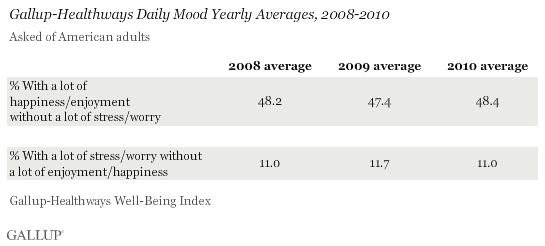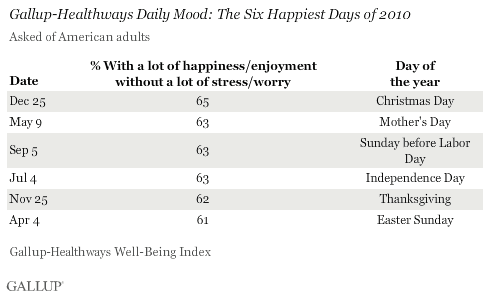WASHINGTON, D.C. -- Americans were, on average, happier and less stressed in 2010 than they were in 2009. The percentage of Americans experiencing a lot of happiness and enjoyment without a lot of stress and worry increased by one percentage point in 2010, while stress decreased by about the same amount.

Americans' self-reports of daily happiness and stress in 2010 improved to match 2008, after declining in 2009.
Data for each year are based on more than 350,000 surveys, conducted as part of the Gallup-Healthways Well-Being Index. As part of the survey, Gallup asks the question "Did you experience a lot of the following yesterday?" and then inquires about several personal experiences, including happiness, enjoyment, stress, and worry. Gallup combines the responses to determine the percentage of respondents who experience a lot of happiness and enjoyment each day but not a lot of stress and worry, and vice versa. Happiness is typically higher on weekends and lower during the workweek.
Holidays Bring Happiest Days of 2010
There were six days in 2010 when happiness rose above 60%, and all of them were on or close to holidays, as they were in prior years. Holidays are days when most Americans spend a more-than-normal amount of time socializing with friends and family, which Gallup research has previously shown to relate to higher levels of happiness and enjoyment and lower levels of stress.
Christmas was the happiest day of 2010, with 65% of Americans reporting experiencing happiness and enjoyment without a lot of stress and worry. Mother's Day, Independence Day, and the Sunday before Labor Day followed closely behind, with happiness at 63%. Thanksgiving and Easter also made it onto the list of the top six happiest days of the year.

Negative News Coincides With Most Stressful, Worrisome Days of 2010
The most stressful day in 2010 coincided with negative economic news, as it did in 2009 and 2008. Stress rose to 18% on Dec. 1, 2010, the day after Federal Reserve Chairman Ben Bernanke publicly expressed concern that the economy was not growing fast enough to reduce unemployment. The statement was widely covered by the media.
Stress had also increased to 18% about two months earlier as severe flooding damaged property and disrupted the lives of thousands of Midwest residents.
The other three most stressful days of 2010 came amid three of the biggest news stories of the year: the 33 trapped Chilean miners, the oil spill in the Gulf of Mexico, and the devastating earthquake in Haiti.

While it is important to note that it is not possible to definitively determine the cause of unusual increases in daily stress and worry, Gallup has over the past three years tracked a pattern that finds high stress and low happiness days occurring on or close to high-profile negative news stories.
About the Gallup-Healthways Well-Being Index
The Gallup-Healthways Well-Being Index tracks U.S. well-being and provides best-in-class solutions for a healthier world. To learn more, please visit well-beingindex.com.
Survey Methods
Results are based on annual sample sizes of more than 350,000 surveys per year and on daily sample sizes of at least 1,000 surveys per day.
For annual results based on the total sample of national adults, one can say with 95% confidence that the maximum margin of sampling error is ±0.2 percentage points. For daily results based on the total sample of national adults, one can say with 95% confidence that the maximum margin of sampling error is ±3 percentage points.
Interviews are conducted with respondents on landline telephones and cellular phones, with interviews conducted in Spanish for respondents who are primarily Spanish-speaking. Each daily sample includes a minimum quota of 150 cell phone respondents and 850 landline respondents, with additional minimum quotas among landline respondents for gender within region. Landline respondents are chosen at random within each household on the basis of which member had the most recent birthday.
Samples are weighted by gender, age, race, Hispanic ethnicity, education, region, adults in the household, cell phone-only status, cell phone-mostly status, and phone lines. Demographic weighting targets are based on the March 2009 Current Population Survey figures for the aged 18 and older non-institutionalized population living in U.S. telephone households. All reported margins of sampling error include the computed design effects for weighting and sample design.
In addition to sampling error, question wording and practical difficulties in conducting surveys can introduce error or bias into the findings of public opinion polls.
For more details on Gallup's polling methodology, visit https://www.gallup.com/.
